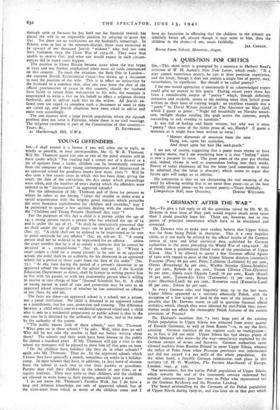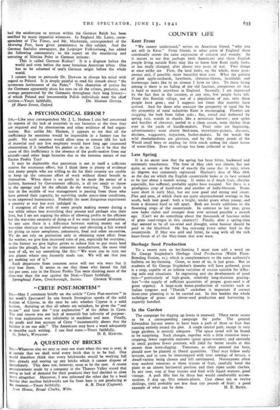,‘ GERMANY AFTER THE WAR " _
SIR,—To give a full reply to all the questions raised by Dr. W. H. Dawson in your issue of May 3oth would require much more space than I could possibly hope for. There are, however, one or two points of principal importance which have to be elucidated and corrected.
Dr. Dawson tries to make your readers believe that Upper Silesia was far from being Polish in character. This is a very hopeless claim, as it can easily be refuted by the official results of the German census of 1910 and other statistical data, published by German authorities in the years preceding the World War of 1914-1918. All of them show a predominant Polish ratio of the population of Upper Silesia. May I be allowed to quote a few German official figures of 1910 with regard to most of the Upper Silesian districts (counties)? Pszczyna (Pless) 86 per cent. Poles, Lubliniec (Lublinitz) 85 per cent., Olesno (Rosenberg) 84 per cent., Wielkie Strzelce (Gross-Strehlitz) 82 per cent., Rybnik 8t per cent., Toszek Gliwice (Toss-Gleiwitz) 8o per cent., Opole rural (Oppeln Land) 78 per cent., Kozle (Kosel) 78 per cent., Tarnowskie Gory (Tarnowitz) 73 per cent., Bytom rural (Beuthen-Land) 69 per cent., Katowice rural (Katowitz-Land) 68 per cent., Zabrze 6o per cent.
In every German atlas and linguistic map, up to the last years, Upper Silesia appeared as a territory ethnically Polish, with the exception of a few scraps of land to the west of the country. Is it possible that Dr. Dawson wants to call in question German official statistics, which, though they were infected by anti-Polish bias, never- theless could not efface the thoroughly Polish features of the eastern provinces of Prussia?
Dr. Dawson's assertion that " a very large part of the existing Polish population in Upper Silesia was attracted from every quarter of Eastern Germany, as well as from Russia "—is, to say the least, amazing. German statistics do not register such an immigration— as, in fact, it did not exist. Upper Silesia has had always plenty of Polish labourers who were—by the way—mercilessly exploited by the German owners of mines and factories. German authorities never allowed workers from Russian Poland to enter Upper Silesia, whereas the influx of Poles from other Prussian provinces was infinitesimal
and did not exceed 1-2 per mire of the whole population. On the other hand, a forcible German colonisation took place in this territory (cf. H. G. Wanklyn, The Eastern Marchlands of Europe, London, 1941, p. x56).
Not newcomers, but the native Polish population of Upper Silesia, which towards the end of the nineteenth century recovered her national consciousness, gave her votes to Poles who represented her at the German Reichstag and the Prussian Landtag.
The brutal mishandling by the Germans of the Polish population of Upper Silesia during 1919-21, and also later on in that part which
had the misfortune to remain within the German Reich has been testified by many impartial witnesses. In England Mr. Lamy, corre- spondent of The Times, and Mr. Mackenzie, correspondent of the Morning Post, have given prominence to this subject. And the German Socialist newspaper, the Leipziger Volkszeitung, has added the following commentary to the report on the murdering and torturing of Silesian Poles in German prisons:
This is called German Kultur! It is a disgrace before the world and even before the most ferocious American tribes. One has to be ashamed of one's German origin before the whole world.
I cannot hope to persuade Dr. Dawson to change his mind with regard to Poland. It is deeply painful to read his remark about " the inveterate lawlessness of the Poles." This champion of justice for the Germans apparently shuts his eyes on all the crimes, perjuries, and wrongs perpetrated by the Germans throughout their long history— of which Poland and innumerable Polish individuals were the chief



























 Previous page
Previous page